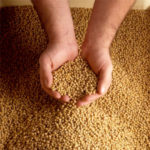Grain futures gained on Tuesday following the U.S. Department of Agricultures weekly crop progress report, published on Monday. Wheat gained for the first time in three days as rains delayed harvesting, which fell far behind last years pace. Corn emerged slower than last year and planted soybean crop was also less.
On the Chicago Mercantile Exchange, wheat futures for July delivery marked a new daily high at $6.8663 a bushel at 10:20 GMT, up 0.80% on the day. Days low stood at $6.8088 a bushel. Despite ample supply forecasts from Australia, Russia and Ukraines Black Sea region and Europe, wheat advanced today as rains delayed winter wheat crop harvesting in the U.S.
In its weekly crop progress report on Monday, the USDA said that only 11% of the winter wheat was harvested as of June 16, compared to the preceding weeks 5%. This is well below last years 51% and the five-year average of 25%.
Meanwhile, 92% of the nations spring wheat was planted up to last week, compared to 100% as of June 16 2012. This is also below the 97% five-year average. Winter wheat condition is worse than the previous season.
This year 43% of the crop is of “Very poor” and “Poor” quality, 26% is “Fair” and 31% belongs to the “Good” and “Excellent” categories. As of the same week 2012, 17% of the winter wheat crop was categorized as “Very poor” and “Poor”, 29% “Fair” and 54% had “Good” and “Excellent” qualities.
Luke Mathews, a commodity strategist at Commonwealth Bank of Australia wrote to Bloomberg: “The current slower-than-normal harvest pace is providing some near price support.”
Worldwide wheat output in the 2013-2014 crop year is expected to be 6.1% higher than the preceding period and near the record level of the 2011-2012 season, totaling 696.9 million metric tons of wheat. Ukraine is expected to boost its wheat export to 8-9 million tons for the 2013-2014 period. Australia projected that its 2013 crop will jump to 25.4 million tons, above last season’s 22.1 million tons and surpassing March’s expectations of a 24.9 production. Germany’s output may rise 7.3% to 24 million tons according to farm industry group Deutscher Raiffeisenverband e.V.
Corn gains
Elsewhere on the grains market, corn futures for July delivery rose by 0.23% for the day, trading at $6.7088 a bushel at 10:00 GMT. The grain ranged between daily high and low at $6.7263 and $6.6800 a bushel respectively.
The USDA said U.S. corn stockpiles before the 2014 harvest will total 1.949 billion bushels, well above market projections of 1.829 billion. This fall’s U.S. harvest will also exceed the 13.82 billion bushels expectations and will total 14.005 billion. The record domestic output will more than double inventories before the 2014 harvest, said the agency.
In its crop progress report on Monday, the USDA said that 92% of the nations corn crop emerged as of June 16, compared to 85% in the previous week. However, this is lower than the comparable week last years complete emerge of the crop and the five-year average of 97%.
The grains condition is comparable to last years with differences of a minor 1% in the “Poor” and “Excellent categories”. During the week ending June 16, corn of “Very poor” and “Poor” quality stood at 8%, “Fair” was 28% and 64% of the crop fell in the “Good” and “Excellent” sections.
Soybeans gain as well
Meanwhile, soybeans also marked a daily gain following the USDA report, although prices were recently pressured as Chinas demand outlook was reduced. The agency report showed soybeans planting fell behind last years pace and stood at 85% as of June 16, up from the preceding weeks 71%. However, this is well below last years 98% and the five-year average of 91%.
Also, soybeans emerged stood at 66% last week, compared to 48% in the preceding period. That is below the 2012 94% figure and the five-year average of 80%.
Soybeans crop condition is better this season with 6% belonging to the “Very poor” and “Poor” categories, 30% to “Fair” and the rest 64% to “Good” and “Excellent”. In comparison, during the same week last year 12% of the crop was of “Very poor” and “Poor” quality, 32% was “Fair” and 54% stood in the “Good” and “Excellent” sections.





